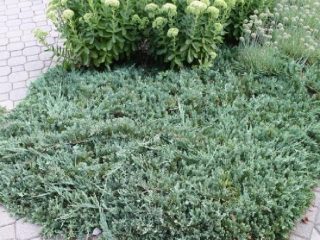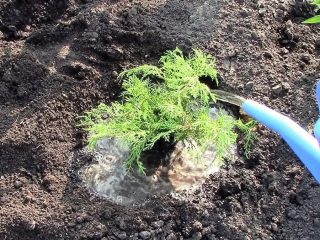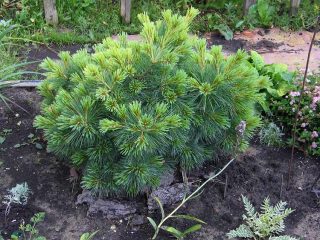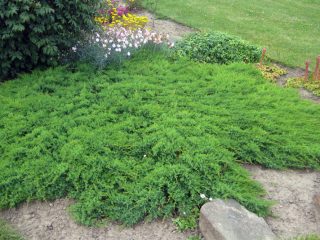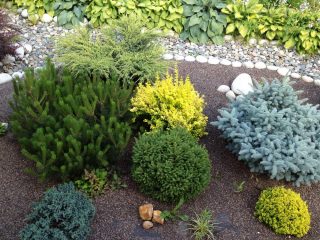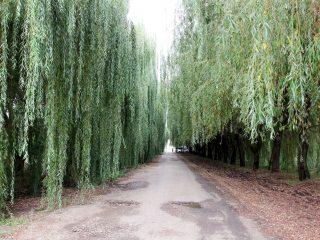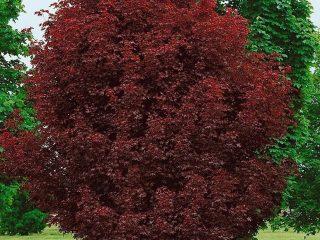Content
Photos and descriptions of the bean shrub show that the plant is represented by many varieties and is distinguished by its unpretentiousness and beauty. Before planting a crop, you need to study its species diversity and basic requirements.
Description and photo of the bean tree
Legume, laburnum or golden shower (Laburnum) is a plant of the Legume family, is a tall shrub or deciduous tree. It has light brown shoots covered with slightly mottled bark. The crown of the plant is oval, the branches droop towards the ground. Trifoliate leaves of a light green hue, almost sessile, are arranged on the stems in an alternate order.
Frost resistance of beans
Bean is a heat-loving plant, similar in frost resistance to apricot.It is recommended to grow the crop in the southern regions and in the west of central Russia. The shrub can withstand frosts down to -27 °C in the presence of shelter, and in the absence of wind - up to -33 °C.
Bean height
The height of laburnum depends on the characteristics of the variety. But on average, the crop can stretch up to 7 m above the ground surface.
How the bean blooms
From late April to June, the bobwhite blooms with small, bright yellow flowers that resemble butterflies in shape. The buds are collected in numerous long racemes, hanging or erect. In September, the fruits of the plant ripen - narrow pods up to 6 cm, filled with small seeds.
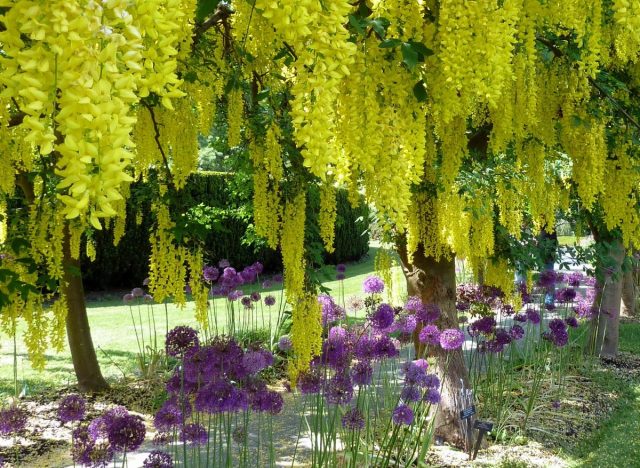
Bean flower clusters reach 20-50 cm in length
Where does bean grow?
In its natural form, laburnum can be found on the Iberian Peninsula, in France and Romania, in Germany, the Czech Republic and the former Yugoslavia. A temperate climate is best suited for the plant. But sometimes laburnum is also found in the subtropics.
Types and varieties of beans
The ornamental bean shrub is represented by many varieties. Several species are most popular among gardeners.
Bobovnik anagyriformes (anagyrofolia)
Anagyroid bean (Laburnum anagyroides) is a tree or large shrub up to 9 m above the ground surface. It has straight branches and bears beautiful golden-yellow buds collected in loose clusters. It blooms at the end of May or at the beginning of June; during the decorative period it emits a faint aroma.
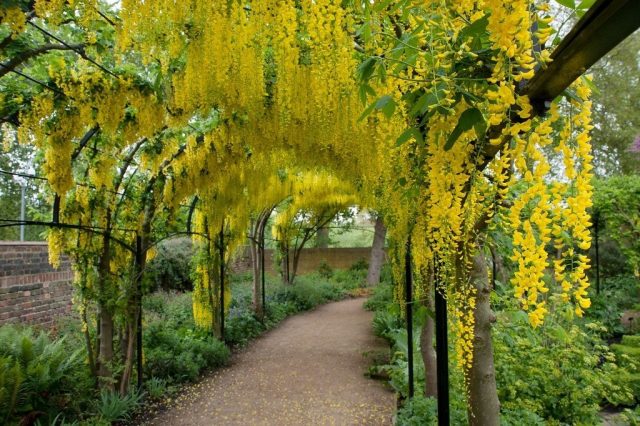
Under natural conditions, anagiroid laburnum grows in France and in the mountains of Central Europe.
The variety has average frost resistance and can withstand cold temperatures down to -25 °C. Loves well-drained, dry soil and plenty of sunlight.Suitable for the middle zone, but may freeze in the absence of snow cover. Growing bean plants in Siberia and northwestern Russia is usually not practiced, since even with high-quality insulation, the bush often dies during the winter.
Alpine bobwhite
Alpine bean (Laburnum alpinum) is a relatively low shrub up to 3 m above the ground surface. It has a wide dome-shaped crown, the rigid branches of the plant bend towards the ground. The shrub can spread up to 2.5 m in diameter.
Alpine laburnum begins to bloom in June. The buds of the shrub are yellow, with a bright, rich aroma, collected in clusters up to 30 cm in length. The variety develops well in the southern regions, but can freeze slightly in the middle zone. In temperate climates it does not bloom annually, but only from time to time.
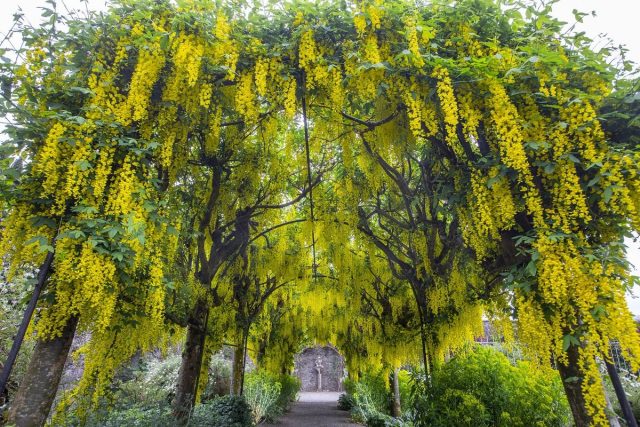
Alpine laburnum begins to bloom for the first time 7-8 years after planting
Waterera
Waterer's bean (Laburnum watereri) is a hybrid plant obtained by crossing the alpine and anagyra varieties. It has erect shoots at a young age; the crown acquires a rounded shape rather slowly. It bears yellow flowers and is distinguished by very large racemes that can reach 60 cm in length. Spreads widely to the sides up to 6 m.
The variety is suitable for breeding in warm climates, and in the northwestern regions and Central Russia it often freezes out in winter. The bush needs fertile soil. The plant tolerates drought well and prefers to grow in lighted areas.
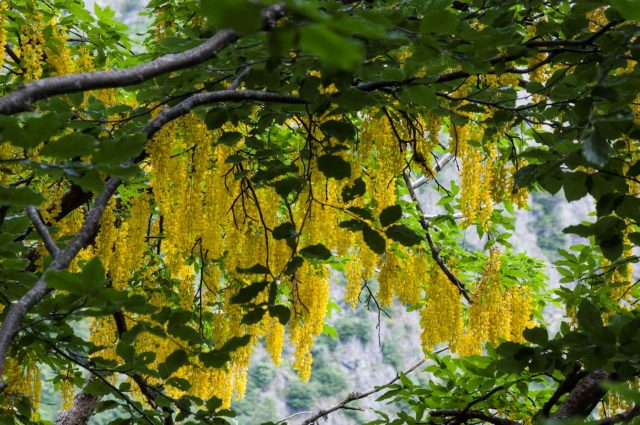
With good care, the Waterera bean tree reaches 4 m in height
Pink bean
Pink or Norway bean (Laburnocytisus adamii) is a hybrid species obtained by crossing laburnum with broom. It is a shrub or small tree up to 8 m above the ground, bearing mainly red, lilac or pinkish inflorescences. At the same time, golden-yellow brushes are also found in the crown - sometimes just a few pieces, sometimes up to half of the total number.
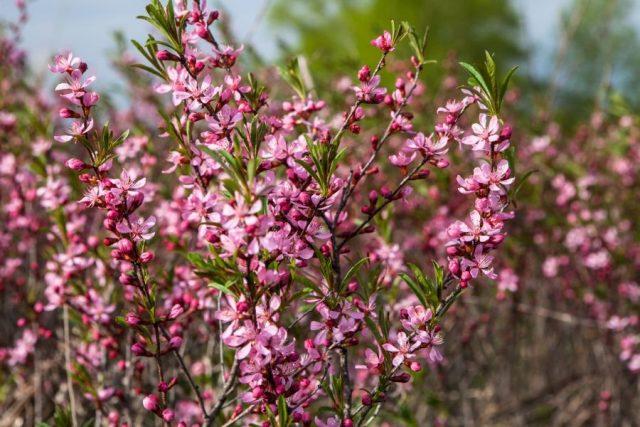
Pink laburnum blooms for two weeks in May.
Bobovnik lilac
All hybrid varieties that bloom not with yellow, but with light purple tassels up to 30 cm long are combined under the name lilac bean. The plant has a strong, pleasant aroma reminiscent of acacia. Flowering usually occurs from late spring to mid-June. The crown of the lilac laburnum is spreading and loose.
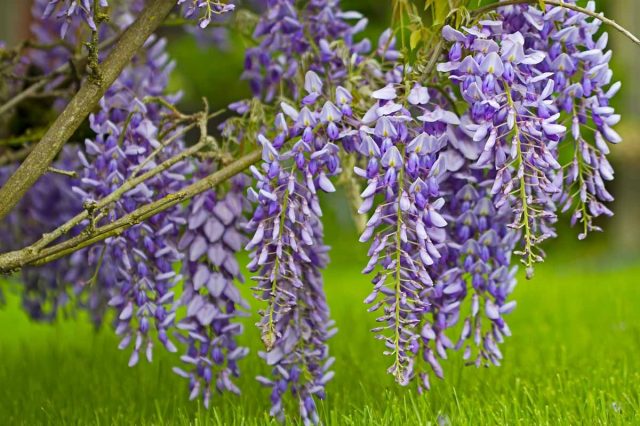
Lilac bean usually grows up to only 2 m above the ground
How to grow beanweed
Planting a bean tree in the Moscow region and caring for it can be associated with certain difficulties. Therefore, it is important to carefully study the requirements of the plant and its characteristics.
On the site for laburnum, choose a sunny or slightly shaded place with good protection from wind and cold drafts. The crop needs loose, permeable soil. It is best to plant the plant on a limestone or sandy substrate. If the soil is poor, this will not interfere with the development of laburnum with regular fertilization.
It is not recommended to plant shrubs in lowlands, in dense shade and on a waterlogged substrate. Against the backdrop of swampiness, laburnum begins to hurt, and with a lack of light, it sheds its leaves and blooms poorly.
It is recommended to plant beans in early spring after the snow has melted and the soil has thawed.The selected area is dug up properly and fertilized with humus or compost. Then holes are prepared for the seedlings, approximately twice the size of the roots. The further landing algorithm is as follows:
- The soil extracted from the ground is mixed with compost.
- A support is placed in the center of the prepared holes, and then a drainage layer and some soil are laid.
- Place the seedlings in the recesses and straighten the roots to the sides.
- Fill the remaining voids with substrate.
- Lightly tamp down the soil and water generously.
Immediately after planting, laburnum is tied to an installed support. The tree trunk circle should be mulched with peat, wood chips or compost.
Care instructions
After planting the bean tree in the spring, it is necessary to provide the shrub with quality care. It consists of several main events.
Watering and fertilizing
From the description of the bean plant it follows that the crop easily tolerates drought, but does not like waterlogging of the soil. Therefore, water the bush very sparingly. Water is added only when the top layer of soil dries out; a lukewarm liquid with a soft composition is used. Watering is done in the morning or in the evening to avoid overheating of the roots under the sun. In rainy weather, additional moisture is completely abandoned.
Fertilizer for ornamental shrubs is applied twice per season. In mid-spring, urea or ammonium nitrate is added to the soil - nitrogen promotes the growth of green mass. The second feeding is carried out in the fall; potassium and phosphorus are added to the soil, increasing the chances of a successful wintering.
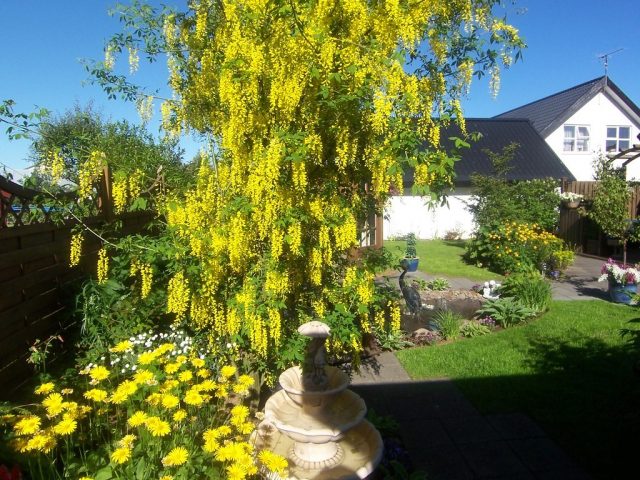
Laburnum is watered a little more often during the flowering period of the crop.
Bean pruning
When growing beans in the middle zone, it is necessary to carry out sanitary pruning for the shrub. During the procedure, all weak, dry and diseased shoots are removed from the plant. It is recommended to trim after the bush has faded. The procedure is usually not carried out in spring. Laburnum tolerates pruning rather poorly and after it produces much fewer buds than usual. For this reason, bushes are not subjected to shaping haircuts - it will do more harm than good.
When pruning a bean plant, the ripening beans are usually removed immediately. The fruits of the plant are highly poisonous, so it is recommended to get rid of them, especially if there are pets or small children on the site.
Wintering
The winter hardiness of the bean plant is not the highest, so leaving it without shelter when autumn arrives is allowed only in the southernmost regions. In the Moscow region and the middle zone, before the cold weather, shrubs are bent to the ground, covered with dry leaves and insulated with agrofibre or spunbond in two layers.
If the winter is expected to be very cold, then it is advisable to additionally cover the plant with spruce branches. After snow falls, a dense snowdrift is formed around the laburnum, which provides protection from the wind.
How to propagate bean grass
The description of the anagyroid bean plant says that the crop can be propagated by seeds and vegetatively. Three methods are popular among gardeners.
Seeds
Growing bean plants from seeds allows you to obtain a hardy and strong plant that can bloom approximately 4-5 years after planting. The bush propagation algorithm looks like this:
- In the spring, after the soil has warmed up, the temporary area is properly dug up.
- Small furrows are made in the ground.
- Bean seeds are buried to 1 cm and sprinkled with soil on top.
- Moisten the soil abundantly.
After the plant sprouts and gets a little stronger, the seedlings can be carefully dug up and moved to a permanent place.
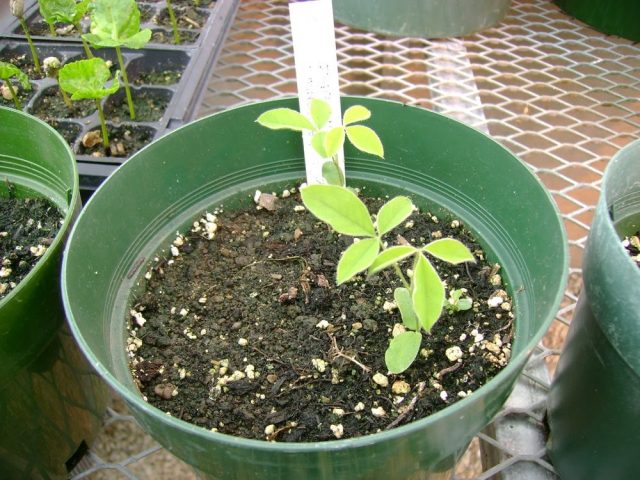
If desired, laburnum can be sprouted in home pots and then transferred to the ground
Bean propagation by cuttings
The crop can be propagated vegetatively by rooting a bean stalk. The procedure is carried out as follows:
- At the end of August or July, several green shoots up to 20 cm long are cut off from an adult plant.
- The cuttings are buried in fertile, loose soil in partial shade.
- Water the shoots generously and cover them with cut plastic bottles.
- The cuttings are ventilated from time to time.
After the laburnum begins to grow, the cover can be removed. During the season, young seedlings are carefully watered, and for the winter, careful insulation is built. After a year, the plants can be moved to a permanent location.
By layering
Young shoots of the bean tree are quite flexible, so they can be used as layering. Reproduction is performed as follows:
- Select a long healthy stem from the lower part of the bush.
- Bend the shoot to the ground and make several neat cuts in the bark.
- Place the stem with its middle part in the ground and secure it from straightening.
- Sprinkle with soil and moisten.
The cuttings need to be watered throughout the season. The shoot will give roots in about a month, but it is recommended to separate it from the mother bush only next year.
Why doesn't the bean flower bloom?
There can be many reasons why laburnum does not bear buds.First of all, it is necessary to remember that after planting, the bean usually blooms no earlier than after 4-5 years.
In addition, the formation of buds can be prevented by:
- unfavorable weather conditions - laburnum blooms irregularly in cold climates;
- lack of sun and fresh air;
- swampy soil or lack of moisture;
- too dense soil with poor aeration.
When growing laburnum, you need to ensure that the soil remains neutral or alkaline. The crop does not like acidic soil and reduces the intensity of flowering.
Bobovnik in landscape design
Photos of the bean shrub show that the plant is widely used in landscape design. In spacious areas, with the help of culture, beautiful shady alleys or tunnels are formed. If there is good drainage, laburnum can be placed on the bank of a pond or stream.
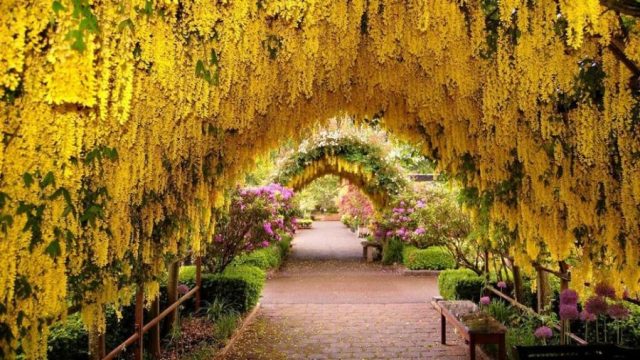
Young laburnum is often attached to trellises to grow as a vine.
You can combine shrubs on your site with lilac and jasmine, hawthorn and witch hazel, and quince. Perennial and annual flowers can coexist with laburnum.
Conclusion
Photos and descriptions of the bean shrub give an idea of a very beautiful tall plant. The downside of the culture is its low frost resistance, but otherwise laburnum is hardy.
Reviews about bobovnik
